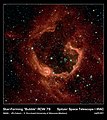File:Star-Forming "Bubble" RCW 79.jpg

Original file (2,600 × 2,925 pixels, file size: 5.17 MB, MIME type: image/jpeg)
Captions
Captions
Summary edit
| DescriptionStar-Forming "Bubble" RCW 79.jpg |
English: RCW 79 is seen in the southern Milky Way, 17,200 light-years from Earth in the constellation Centaurus. The bubble is 70-light years in diameter, and probably took about one million years to form from the radiation and winds of hot young stars.
The balloon of gas and dust is an example of stimulated star formation. Such stars are born when the hot bubble expands into the interstellar gas and dust around it. RCW 79 has spawned at least two groups of new stars along the edge of the large bubble. Some are visible inside the small bubble in the lower left corner. Another group of baby stars appears near the opening at the top. NASA's Spitzer Space Telescope easily detects infrared light from the dust particles in RCW 79. The young stars within RCW79 radiate ultraviolet light that excites molecules of dust within the bubble. This causes the dust grains to emit infrared light that is detected by Spitzer and seen here as the extended red features. |
| Date | |
| Source | http://www.spitzer.caltech.edu/images/2324-sig05-001-A-Bubble-Bursts |
| Author | NASA/JPL-Caltech/E. Churchwell (University of Wisconsin-Madison) |
Image use policy: http://www.spitzer.caltech.edu/info/18-Image-Use-Policy
Licensing edit
| Public domainPublic domainfalsefalse |
| This file is in the public domain in the United States because it was solely created by NASA. NASA copyright policy states that "NASA material is not protected by copyright unless noted". (See Template:PD-USGov, NASA copyright policy page or JPL Image Use Policy.) |  | |
 |
Warnings:
|
File history
Click on a date/time to view the file as it appeared at that time.
| Date/Time | Thumbnail | Dimensions | User | Comment | |
|---|---|---|---|---|---|
| current | 20:17, 21 June 2011 |  | 2,600 × 2,925 (5.17 MB) | Spitzersteph (talk | contribs) |
You cannot overwrite this file.
File usage on Commons
There are no pages that use this file.
File usage on other wikis
The following other wikis use this file:
Metadata
This file contains additional information such as Exif metadata which may have been added by the digital camera, scanner, or software program used to create or digitize it. If the file has been modified from its original state, some details such as the timestamp may not fully reflect those of the original file. The timestamp is only as accurate as the clock in the camera, and it may be completely wrong.
| Author | Spitzer Space Telescope |
|---|---|
| Copyright holder | http://www.spitzer.caltech.edu/Media/mediaimages/copyright.shtml |
| Width | 2,600 px |
| Height | 2,925 px |
| Compression scheme | LZW |
| Pixel composition | RGB |
| Orientation | Normal |
| Number of components | 4 |
| Horizontal resolution | 325 dpi |
| Vertical resolution | 325 dpi |
| Data arrangement | chunky format |
| Software used | Adobe Photoshop CS3 Macintosh |
| File change date and time | 14:30, 5 June 2009 |
| Color space | Uncalibrated |